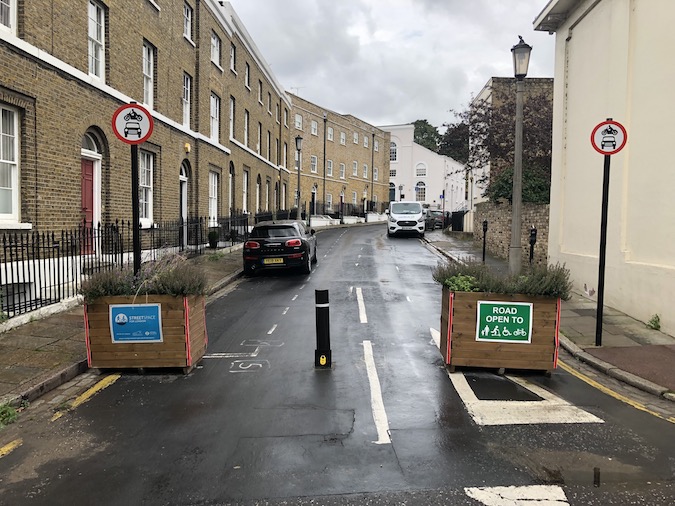Last month Greenwich Council removed its Low Traffic Neighbourhood scheme in West Greenwich. In doing so it joined eight other boroughs of varying political persuasions that introduced LTNs or other Streetspace schemes without prior consultation at the onset of the pandemic and have since removed some or all of them: Ealing, Harrow, Brent, Sutton, Tower Hamlets, Redbridge, Kensington & Chelsea and Wandsworth.
It is clear that the rushed attempt to introduce these measures has failed to capture Londoners’ imaginations. Every time a council consulted about their continuation a majority of respondents rejected them. It didn’t help local democracy that a number of councils used the equivalent of creative accounting to claim success for their schemes. Meanwhile, car ownership and usage has continued to increase even in the LTN heartlands of Hackney and Waltham Forest.
So, if LTNs have a limited future in changing travel habits and improving air quality, what else is on offer? Well, whisper it, but it looks as if London is seeing an increase in road pricing, albeit by stealth. As part of the financial package for the new Silvertown Tunnel both it and the existing Blackwall Tunnel will be tolled. There is also an intriguing discussion about a possible “bridge tax” being introduced as part of resolving saga of Hammersmith Bridge.
And perhaps the most noticeable development is the decision by Sadiq Kahn to extend the Ultra Low Emission Zone (ULEZ) to cover the whole of London. As well as helping to improve air quality across the capital, this decision means the provision of infrastructure that can be adapted for further regulation of the types of vehicles that use London’s roads and the times of day they use them. Paris already limits the hours in which HGV and other commercial vehicles can use its roads. Perhaps in future London can do the same.
The current piecemeal approach to road pricing justifies specific schemes and is taking place in the context of Transport for London’s precarious financial position. But it is now time to be bolder and make the public case for a more comprehensive road pricing strategy which, if implemented properly, could lead to fundamental changes in driver behaviour and help transform public transport.
For that to happen will require courageous politicians and a shift in the debate to include a better way to talk to London’s motorists.
Maybe all those involved in today’s fractious transport debate could learn something from the campaign that persuaded Britain to stop smoking in the 1990s. Younger readers may be astonished to learn that before then it was perfectly possible to smoke in pubs, buses, Tube trains and workplaces, and millions did.
It’s now against the law to do so, but the legislation was preceded by a huge health and media campaign to persuade people to quit. This included incentives and alternatives to smoking, such as nicotine patches, for those who needed them. Smokers weren’t hounded and their predicament was understood. They went from the majority to the minority within a decade, despite the efforts of the powerful tobacco lobby.
We could adapt that approach for the traffic debate. For example, we could offer subsidised or free travel to motorists willing to give up their cars, as they’ve begun to do in Barcelona. In Stockholm, they’ve experimented with a scheme that rewarded motorists who kept to the speed limit with entry to a monthly lottery whose prizes were funded by the fines of the motorists who didn’t.
While we must acknowledge the strained finances of TfL – largely caused by that champion of cyclists, Boris Johnson’s transport adviser Andrew Gilligan – we could focus much more on improving bus reliability. London buses are the workhorses of the capital’s public transport, providing a staggering two billion passenger journeys a year. Unlike expensive grand projects like Crossrail, improvements to bus services are relatively cheap and quick to implement.
Instead, we are going backwards by prioritising cycle lanes over bus lanes in large parts of London and directing traffic onto already congested main roads. Perhaps given the relative sizes of the bus and cycle communities maybe it’s time the Mayor created a Bus Czar?
Sadly, far too many of the current transport advocacy groups seem intent on demonising drivers as uncaring “rat runners” and similar charming epithets. It’s the equivalent of the anti-smoking lobby going round pubs in the 1990s accusing smokers of killing all the customers there – good for the soul but unlikely to change behaviour.
Moreover, the road rage fuelled by LTNs has split a coalition that should be working together to reduce congestion and poor air quality. It’s time for a truce after the road wars about the Covid LTNs – a surreal struggle over less than four per cent of London road space. If we instead work together, an advanced road pricing system and a significant reduction in motor traffic could be closer than we think.
Paul Wheeler writes about local politics. Follow him on Twitter.
On London is a small but influential website which strives to provide more of the kind of journalism the capital city needs. Become a supporter for £5 a month or £50 a year and receive an action-packed weekly newsletter and free entry to online events. Details here.
